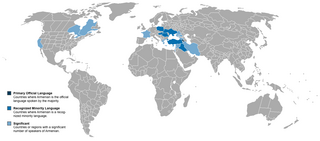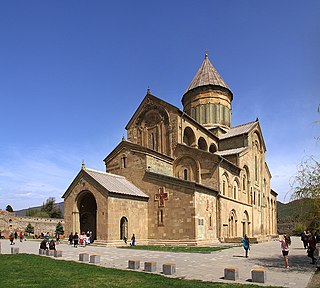
The Svetitskhoveli Cathedral is an Eastern Orthodox cathedral located in the historic town of Mtskheta, Georgia, to the northwest of the Georgian capital Tbilisi. A masterpiece of the Early Middle Ages, Svetitskhoveli is recognized by UNESCO as a World Heritage Site. It is currently the second largest church building in Georgia, after the Holy Trinity Cathedral.

The Holy Trinity Cathedral of Tbilisi commonly known as Sameba is the main cathedral of the Georgian Orthodox Church located in Tbilisi, the capital of Georgia. Constructed between 1995 and 2004, it is the third-tallest Eastern Orthodox cathedral in the world and one of the largest religious buildings in the world by total area. Sameba is a synthesis of traditional styles dominating the Georgian church architecture at various stages in history and has some Byzantine undertones.

Saint Hripsime Church is a seventh century Armenian Apostolic church in the city of Vagharshapat (Etchmiadzin), Armenia. It is one of the oldest surviving churches in the country. The church was erected by Catholicos Komitas to replace the original mausoleum built by Catholicos Sahak the Great in 395 AD that contained the remains of the martyred Saint Hripsime to whom the church is dedicated. The current structure was completed in 618 AD. It is known for its fine Armenian-style architecture of the classical period, which has influenced many other Armenian churches since. It was listed as a UNESCO World Heritage Site along with other nearby churches, including Etchmiadzin Cathedral, Armenia's mother church, in 2000.

Ani is a ruined medieval Armenian city now situated in Turkey's province of Kars, next to the closed border with Armenia.
Armenians in Georgia are Armenian people living within the country of Georgia. The Armenian community is mostly concentrated in the capital Tbilisi, Autonomous Republic of Abkhazia and Samtskhe-Javakheti region. Official Georgian statistics put the Armenians in Samtskhe-Javakheti at about 54% of the population. In Abkhazia, Armenians are the third biggest ethnic group in the region after the Georgians and the Abkhazian majority.

Saint George's Church is a 13th-century Armenian church in the old city of Tbilisi, Georgia's capital. It is one of the two functioning Armenian churches in Tbilisi and is the cathedral of the Georgian Diocese of the Armenian Apostolic Church. It is located in the south-western corner of Vakhtang Gorgasali Square (Meidani) and is overlooked by the ruins of Narikala fortress.

Mughni is a village in the Aragatsotn Province of Armenia. It is located just to the north of Ashtarak town and belongs to its municipality. Until the Russian conquest, it was the southernmost town in the district of Aparan. Mughni is home to the 14th-century Saint Gevork Monastery, which was formerly a popular pilgrimage site and the seat of an archbishop. The dome of the church was rebuilt in the 1660s.

Bana, also known by the modern Turkish designation Penek Kilisesi, is a ruined early medieval cathedral in present-day Erzurum Province, eastern Turkey, in what had formerly been a historical marchland known to Armenians as Tayk and to Georgians as Tao.
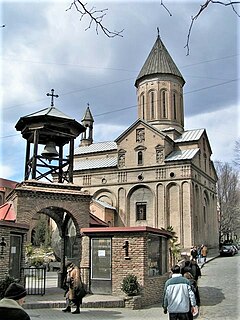
Norashen Holy Mother of God Church is a 15th-century Armenian church located in Old Tbilisi, Georgia. It was founded in 1467 and renovated in 1650. It also underwent renovations later in 1795, 1808, and 1875.

The Church of the Red Gospel or Shamkoretsots Sourb Astvatsatsin Church is a ruined 18th century Armenian church in the Avlabar district of Old Tbilisi, Tbilisi, Georgia.

The Ejmiatsin Church is an 18th-century Armenian Apostolic church in the Avlabari district of Old Tbilisi, Georgia. The church is adjacent to the Avlabari Square.

The Armenian Pantheon of Tbilisi, also known as Khojivank or Khojavank, is an Armenian architectural complex in north-eastern part of Avlabari district of Tbilisi, Georgia. Many notable Armenian writers, artists and public figures are buried there.

Holy Mother of God Church of Bethlehem is a church in Tbilisi, Georgia. Built as an Armenian church in the 18th century, on the site of an older church, it now operates as a Georgian orthodox church.
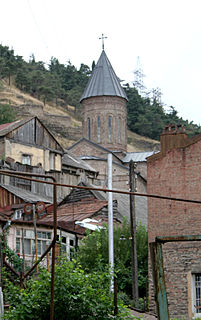
The Lower Bethlemi Church(Georgian: ქვემო ბეთლემის ეკლესია), also known as the Church of Saint Stepanos of the Holy Virgins or Koosanats Sourb Stepanos Vank) – is a 14th–19th-century church at the foot of Narikala fortress in Old Tbilisi, Georgia. It was rebuilt between 1868 and 1870 and operated as an Armenian church. In 1988 it was given to the Georgian Orthodox and its Armenian identity was "Georgianized" in 1991.

The Qarapi Saint Gevorg church is an 18th-century church at the foot of the Narikala citadel in Old Tbilisi, Georgia. The church is single-naved and was built in 1753. The Georgian Orthodox Church was built on the site of an ancient Georgian church which was built during the reign of St. King Vakhtang I of Iberia. The church was reconstructed with the help of Armenian merchant Petros Zohrabian and his wife Lolita and the restoration held by them in 1735, what makes the church one of the most important examples of Georgian-Armenian friendship and cooperation.

Saint Karapet Church is an Armenian church now functioning as Georgian Orthodox church in Old Tbilisi, Georgia. It is located between the Chugureti and Avlabari districts.

Saint Sarkis Church, is an Armenian church in Harpukh Sulfuric Baths district of Old Tbilisi, Georgia. Destroyed by Lavrentiy Beria order in 1930s.

Zrkinyants Saint Gevork Church was an Armenian Apostolic church in Tbilisi, Georgia. It was destroyed in 1937-38 by order of Lavrentiy Beria along with 10 other churches in Tbilisi.
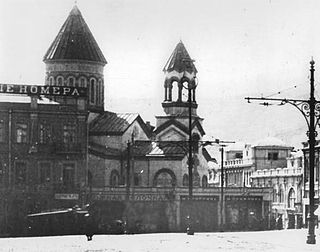
Kamoyants Saint Gevork Church was an Armenian Apostolic church in Tbilisi, Georgia. It was destroyed in 1937-38 by order of Lavrentiy Beria along with 10 other churches in Tbilisi.
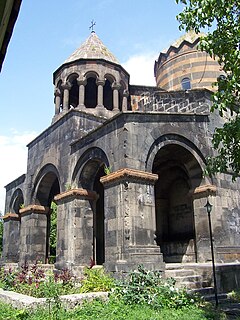
Saint Gevork Monastery or Saint George's Monastery of Mughni is located just off of the main road that runs through the village of Mughni near Ashtarak in the Aragatsotn Province of Armenia. It was built to house some of the remains of Saint George who was known as the "Slayer of Dragons".
